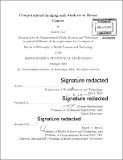| dc.contributor.advisor | George Barbastathis. | en_US |
| dc.contributor.author | Lee, Justin Wu | en_US |
| dc.contributor.other | Harvard--MIT Program in Health Sciences and Technology. | en_US |
| dc.date.accessioned | 2018-05-23T16:31:01Z | |
| dc.date.available | 2018-05-23T16:31:01Z | |
| dc.date.copyright | 2018 | en_US |
| dc.date.issued | 2018 | en_US |
| dc.identifier.uri | http://hdl.handle.net/1721.1/115703 | |
| dc.description | Thesis: Ph. D. in Biomedical Engineering, Harvard-MIT Program in Health Sciences and Technology, 2018. | en_US |
| dc.description | Cataloged from PDF version of thesis. | en_US |
| dc.description | Includes bibliographical references (pages 125-136). | en_US |
| dc.description.abstract | The conventional pathologic analysis of malignancies involves a qualitative characterization and integration of several factors including tumor size, general degree of differentiation, tumor heterogeneity, mitotic rate, and lymphovascular invasion. For some cancers, biomarkers such as hormone receptor expression or receptor kinase over-expression can provide additional prognostic and therapeutic guidance. Unfortunately, all of these qualitative histologic approaches, while generally accepted for directing patient care, often exhibit significant inter-observer variability resulting in inconsistent inter- and intra-institutional predictions of tumor behavior (including metastases and/or recurrence), resulting in incorrect diagnoses or treatment. Because cellular morphology is an integrated reflection of genetic and epigenetic expression, we hypothesize that a more accurate quantitative accounting and measurement of histologic features can provide a more robust and reliable prediction of tumor behavior. Computational imaging utilizes software to augment or replace the role of traditional optical elements in imaging systems and has an ability to significantly increase the accuracy, robustness and cost-efficiency of digital pathology. In this thesis, we develop and test three novel computational imaging algorithms including, to the best of our knowledge, the first system for lensless computational imaging through deep learning. We then test our hypothesis by applying augmented image retrieval, analysis algorithms, and machine learning on a validated dataset of breast cancer images where the clinical outcomes of the primary tumor are known. In particular, we analyze algorithms related to identifying mitoses as a central proof of concept. | en_US |
| dc.description.statementofresponsibility | by Justin Lee. | en_US |
| dc.format.extent | 136 pages | en_US |
| dc.language.iso | eng | en_US |
| dc.publisher | Massachusetts Institute of Technology | en_US |
| dc.rights | MIT theses are protected by copyright. They may be viewed, downloaded, or printed from this source but further reproduction or distribution in any format is prohibited without written permission. | en_US |
| dc.rights.uri | http://dspace.mit.edu/handle/1721.1/7582 | en_US |
| dc.subject | Harvard--MIT Program in Health Sciences and Technology. | en_US |
| dc.title | Computational imaging and analysis in breast cancer | en_US |
| dc.type | Thesis | en_US |
| dc.description.degree | Ph. D. in Biomedical Engineering | en_US |
| dc.contributor.department | Harvard University--MIT Division of Health Sciences and Technology | |
| dc.identifier.oclc | 1036986028 | en_US |
